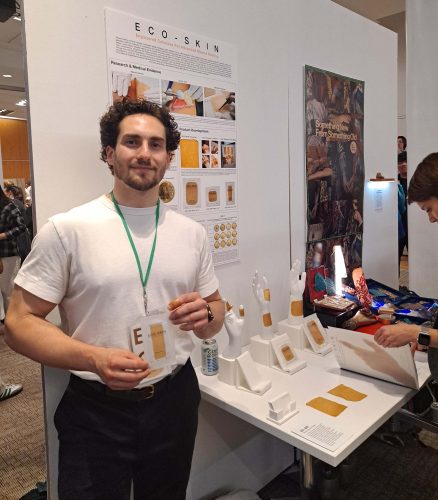
Parsons Teams Research Eco-Friendly Wound Care and Speculative Worlds at the Biodesign Challenge Summit
The New School and the Museum of Modern Art recently presented the tenth annual Biodesign Challenge Summit, a competition that tasked 65 university and high school teams from 24 countries with creating projects that bridge art, design, and biotechnology. Two teams from The New School competed, including Jonah Goodman, MFA Industrial Design ’25, who designed Eco-Skin, which received the Outstanding Science Prize and was a finalist for the Glass Microbe, awarded to the overall winner of the challenge; and Kairu Tong, BFA Product Design ’25, and Jordan Fong, BFA Communication Design ’26, creators of Building a Transutopia with GVS. New School faculty were also highlighted at the event: Carolina Obregón, an assistant professor of fashion design and instructor for the Biodesign Challenge course, delivered the keynote speech, “How Did I Become Biodesign? 10 Lessons in Ten Years.”
The challenge aligns closely with Parsons School of Design’s mission of promoting transformational design, giving participants an opportunity to explore the impact of biotechnology on society and ways to design with it ethically and thoughtfully. Eco-Skin is a bioactive wound dressing made from bacterial cellulose produced through fermentation of kombucha with a symbiotic culture of bacteria and yeast (SCOBY). The project was informed by Goodman’s own history of health problems, which are ameliorated by consuming fermented foods that promote a healthy gut biome. He came to Parsons “with the goal of designing everything for, with, and by bacteria.”
“Biodesign is a completely new way to design, where an industrial designer with no formal training in microbiology can do legitimate testing, such as Kirby-Bauer disk diffusion, beta-salic production, user usability tests. It’s changed the game because what was available to scientists 20 years ago is now available to designers,” says Goodman.

“It’s a real acknowledgment, I would say, both of Jonah’s project and his hard work but also of this idea that even though art and design schools don’t have the resources or the rigorous science education that R1 research institutions have, we can still create projects informed by rigorous science,” says Jane Pirone, an associate professor of design ecologies and instructor for the Biodesign Challenge course. “Our students do spend quite a bit of time with Dr. Katayoun Chamany, Mohn Family Professor of Natural Sciences and Mathematics, who leads them through a lot of science methodology, scientific methods, and a lot about ethics and social justice. To have these things acknowledged in what is primarily known as a design school is pretty phenomenal because what it means is artists and designers can collaborate with scientists, and they can learn these techniques and apply them to their work.”
“Part of why the Biodesign Challenge is so amazing is that not only do these projects present possibilities for students, who have huge success, but the projects can become a reality and create change in the world that we can only do through biology and design,” says Obregón.
It’s easy to see the practical applications of Goodman’s project. Tong and Fong took a more theoretical approach to their work. Their project gave them an opportunity to look closely at marginalized communities and question the framework that decides which communities get to be designed for and why. “‘Building a Transutopia with GVS’ is not a typical biodesign challenge project, as it’s a speculative project. We thought it was interesting to create a speculative world, and once we started playing with it more, we realized how strong of a medium it is. As designers by trade, we wanted to use our skills and make people think about the binary, the social structures that they’re already in, and restructure that from the ground up,” says Fong.
The interdisciplinarity of the challenge encourages participants to not only rely on their own technical skills but engage with others in exploring actual applications and social justice implications and gain an expansive view of the world. “Design work can sometimes feel very specific—within a bubble. What’s nice about the Biodesign Challenge and what’s more reflective of real-world collaboration is that you’re working with so many different types of people, and your projects can be so much better because you’re aided with these perspectives and expertise that you don’t understand as well. They have their strengths and you have yours. That’s important to get outside of your niche of what design looks like in your mind,” says Tong.
While Pirone and Obregón are the main faculty members leading the course, they emphasize that it’s a cross-disciplinary effort, pulling in instructors from across the university, such as Chamany and Harpreet Sareen, an assistant professor of interaction and media design and assistant professor of art, design, and social justice. “Part of what we’re teaching, beyond the specifics of the discipline itself, is that complexity requires collaboration and that collaboration is part of the beauty of what we try to do at The New School,” says Pirone. “This transdisciplinary, cross-disciplinary kind of collaborative approach to innovation applies to faculty as well, so there’s lots of folks contributing to this, whether directly or indirectly. We believe this is the future of all design, and without this, we can’t address any of the challenges we face as humans.”